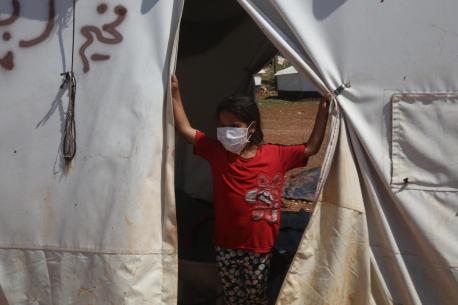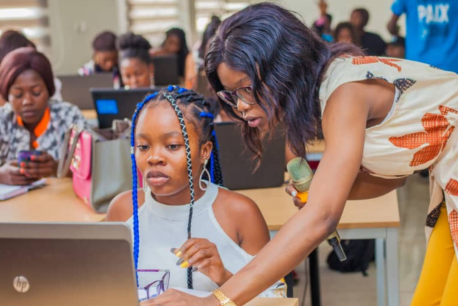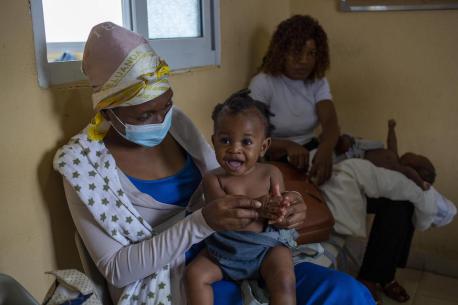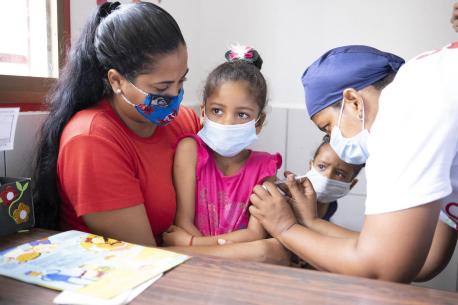
Advocating for Child Protection During the COVID-19 Response
UNICEF USA is urging the U.S. government to implement a global response to heightened child protection risks during the pandemic.
The End Violence Against Children Taskforce, a group of NGOs who collectively urge the U.S. government to prioritize the prevention and response to violence, exploitation, neglect, and abuse against children around the world, has crafted the following response to heightened child protection risks during the COVID-19 pandemic.
Since the start of the crisis, COVID-19 has generated countless headlines, with most focusing on public health challenges, the economic downturn, and efforts to encourage social distancing. A less talked about, but no less important topic, is how the pandemic threatens the safety and security of children.
As schools and services shutter and as social and community networks come under stress, children — particularly the most vulnerable — are at heightened risk of violence, abuse, exploitation, and neglect. What is worse, due to the nature of the crisis, child protection services and reporting mechanisms are even more constrained and less able to respond.
Ending violence against children is one of the key elements of child protection, a broad umbrella that refers to the prevention and response to violence, exploitation, and abuse of children in all contexts. Child protection programs and interventions must account not just for physical violence, but also its many other forms including mental, sexual and social-emotional.
The COVID-19 pandemic threatens the safety and security of children worldwide
As life continues to be disrupted by COVID-19, many children face increased exposure to domestic violence and neglect from caregivers, especially where financial and health burdens and other stressors have increased. Domestic violence reports are surging as a result of the pandemic at a time when fewer adult eyes, such as teachers, are able to detect and respond to abuse. COVID-19 has cut children off from their friends, their regular schooling, and their freedom of movement. Social isolation and a lost feeling of belonging are among the highest risks for young people in this situation and can trigger an avalanche of undesirable consequences.
COVID-19 is causing fear, anxiety, and psychological distress across families. Science has shown that when a child experiences prolonged stress, it can cause irreversible damage, hindering cognitive development and altering long-term health. With increased and intensified national lockdowns and forced quarantines putting an economic strain on families across the globe, many vulnerable children face an increased risk of being forced into early marriage, engaging in hazardous child labor, and becoming victims of trafficking.
Around the world, children with existing vulnerabilities, including children with disabilities, children migrating and/or facing displacement, ethnic minorities and children living outside of family care are most at risk. When children or their family members contract COVID-19, discrimination and stigmatization are exacerbated.
Even children in nurturing and safe family environments are not immune to these and other child protection risks. For example, with an increasing number of children in the U.S. and other countries at home and tasked with completing online schoolwork, many children are at higher risk of experiencing online bullying, sexual abuse, and exploitation due to longer hours spent on the internet, often with limited caregiver supervision.
Child protection policy and programmatic recommendations
Maintain and expand funding for existing humanitarian and development programs: In this crucial time, funding for existing humanitarian and development programs should continue with added flexibility to address communities’ new needs and to integrate interventions to address COVID-19 and protect children. We caution against diverting existing program funding to the pandemic response.
Given the unprecedented scale of the COVID-19 pandemic, we urge Congress to authorize robust funding for foreign assistance programs that address the unique and urgent child protection challenges presented by this pandemic. Investments in the International Disaster Assistance, Migration and Refugee Assistance, and Economic Support Fund accounts will facilitate rapid disbursement of funds and provide USAID with the necessary flexibility to address changing realities on the ground. In addition, Congress must exert appropriate oversight over the administration’s international COVID-19 response efforts to ensure that interventions protecting children from violence are integrated throughout its programming.
Develop guidelines for sustaining child-focused foreign assistance programs during COVID-19: We urge all child-focused foreign assistance programs to develop guidelines that call for sustained programming even if targets need to be adjusted. For example, USAID provided COVID-19 technical guidance on PEPFAR, which stresses program continuity and flexibility and includes specific guidance for children and adolescents. Where programming has been disrupted by national quarantines and travel restrictions, guidelines should include low- and high-tech adaptations to reach children safely. Special consideration should be given to online child protection as more and more children and families turn to the internet for services and resources. As a global community, we do not want to lose the progress we have made towards ending violence against children.
All U.S. government support for the COVID-19 response should ensure that actors uphold key standards for child protection: Despite increased risks and challenges, tools and resources do exist for supporting child protection during COVID-19 including:
- Technical Note: Protection of Children during the Coronavirus Pandemic (v.1), a technical note on child protection during the coronavirus pandemic released by The Alliance for Child Protection in Humanitarian Action, describes how the virus mitigation efforts increase children’s risk of experiencing violence and provides important programmatic responses to address these risks.
- INSPIRE, a set of seven evidence-based strategies to end violence against children, developed in coordination with the CDC, USAID, UNICEF, the World Health Organization and others, can also be adapted for emergency settings.
- COVID-19 and its implications for protecting children online sets out key priorities and recommendations on how to mitigate the risks brought on by increased online presence and promote positive online experiences for children.
These tools emphasize the need for a multi-sectoral approach to addressing and preventing violence against children during the current crisis. Child protection considerations should be integrated into all COVID-related responses, including in health, nutrition, and education services.
Support for caregivers must not be overlooked as a critical component of a holistic strategy to protect children during this crisis: With more children at home, parents and caregivers will shoulder even more responsibility in protecting children. Supporting caregivers’ mental health and encouraging their development of positive parenting skills will have a catalytic effect on their children’s mental health and well-being. For children outside of parental care, protocols should include family-based care alternatives.
Family-centered care has a proven positive influence on children’s well-being, but the additional stressors COVID-19 presents for vulnerable families need to be accounted for in child protection programming. Children of all ages rely on their primary caregivers to provide a sense of safety and security and to help them make sense of stressful or traumatic events.
End Violence Against Children Taskforce: American Academy of Pediatrics, ChildFund, Futures Without Violence, Save the Children, UNICEF USA, and World Vision have rallied together to prioritize ending violence against children in U.S. foreign policy and assistance. Together we seek to elevate, intensify and improve U.S. government commitments on the prevention and response to violence, exploitation, neglect, and abuse against children around the world in all settings through engagement with Congress, the administration, and civil society.
Top photo: On April 19, 2020, a girl stands in the doorway of her family's home in a tent camp for displaced Syrians near the town of Kafr Yahmoul, north of Idlib, Syria while UNICEF-supported volunteers share messaging around staying safe and healthy during the time of the COVID-19 outbreak. © UNICEF/UNI322979/Albam
HOW TO HELP
There are many ways to make a difference
War, famine, poverty, natural disasters — threats to the world's children keep coming. But UNICEF won't stop working to keep children healthy and safe.
UNICEF works in over 190 countries and territories — more places than any other children's organization. UNICEF has the world's largest humanitarian warehouse and, when disaster strikes, can get supplies almost anywhere within 72 hours. Constantly innovating, always advocating for a better world for children, UNICEF works to ensure that every child can grow up healthy, educated, protected and respected.
Would you like to help give all children the opportunity to reach their full potential? There are many ways to get involved.





